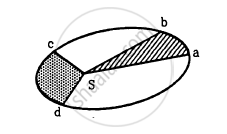Advertisements
Advertisements
प्रश्न
Both earth and moon are subject to the gravitational force of the sun. As observed from the sun, the orbit of the moon ______.
पर्याय
will be elliptical.
will not be strictly elliptical because the total gravitational force on it is not central.
is not elliptical but will necessarily be a closed curve.
deviates considerably from being elliptical due to influence of planets other than earth.
उत्तर
Both earth and moon are subject to the gravitational force of the sun. As observed from the sun, the orbit of the moon will not be strictly elliptical because the total gravitational force on it is not central.
Explanation:
The moon revolves around the earth in a nearly circular orbit. When it is observed from the sun, two types of forces are acting on the moon one is due to gravitational attraction between the sun and the moon and the other is due to gravitational attraction between the earth and the moon. So the moon is moving under the combined gravitational pull acting on it due to the earth and the sun. Hence, the total force on the moon is not central.
APPEARS IN
संबंधित प्रश्न
Let us assume that our galaxy consists of 2.5 × 1011 stars each of one solar mass. How long will a star at a distance of 50,000 ly from the galactic centre take to complete one revolution? Take the diameter of the Milky Way to be 105 ly
State Kepler's laws of planetary motion.
In the Following figure shows the elliptical path of a planet about the sun. The two shaded parts have equal area. If t1 and t2 be the time taken by the planet to go from a to b and from c to d respectively,

Answer the following question.
State Kepler’s law of equal areas.
Answer the following question.
State Kepler’s law of the period.
The square of its period of revolution around the sun is directly proportional to the _______ of the mean distance of a planet from the sun.
Observe the given figure and answer these following questions.

The orbit of a planet moving around the Sun
- What is the conclusion about the orbit of a planet?
- What is the relation between velocity of planet and distance from sun?
- Explain the relation between areas ASB, CSD and ESF.
State Kepler’s laws.
Give one example each of central force and non-central force.
What is the direction of areal velocity of the earth around the sun?
